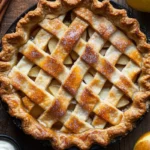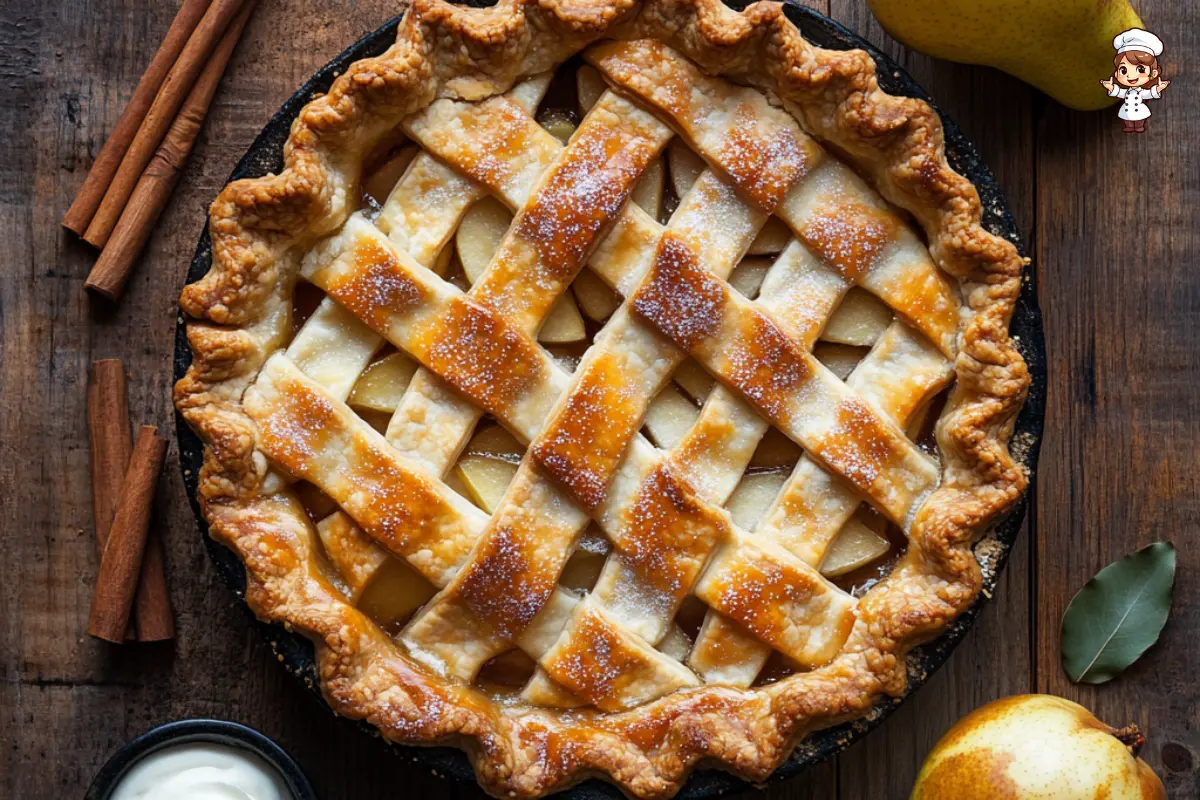Pear pie is a delightful treat that balances the natural sweetness of pears with the flaky texture of a well-baked crust. Whether you’re a seasoned baker or a beginner looking for an impressive dessert, this guide will take you through every step of crafting a delectable pear pie recipe. From selecting the best pears to mastering baking techniques, we’ve got you covered. Let’s embark on this flavorful journey!
What is a Pear Pie?
Pear pie is a dessert that celebrates the soft, juicy texture and subtle sweetness of pears, encased in a buttery crust. Unlike the more common apple pie, pear pie brings a lighter, fruitier twist, making it a perfect choice for any occasion. Its spiced pear filling often includes cinnamon or nutmeg, adding warmth and depth to its flavor profile.
Why Pears Are Perfect for Pies
Pears are an underrated fruit for baking, but their natural sweetness and juicy consistency make them ideal for pies. They absorb spices and sugar beautifully, creating a filling that’s both rich and aromatic. Unlike other fruits, pears hold their shape during baking, ensuring a pie that’s as visually appealing as it is tasty.
A Brief History of Fruit Pies
The history of fruit pies stretches back centuries, with their origins rooted in medieval Europe. Back then, pies were a way to preserve fruit and enjoy it out of season. Pear pies, specifically, gained popularity in regions where pears thrived, like France and England. Today, they remain a beloved dessert that marries tradition with versatility.
With this introduction, you’re ready to dive into the essentials of creating the best pear pie recipe. Stay tuned as we explore how to choose the right pears and prepare the perfect pie crust in the following parts!
Choosing the Best Pears for Your Pie
Varieties of Pears: Which Are Best?
When it comes to creating a pear pie recipe, the type of pear you choose can make or break your dessert. Bartlett pears, known for their sweetness and juiciness, are a popular choice. If you’re after a firmer texture, Bosc pears are perfect because they hold their shape well during baking. Anjou pears, with their mild flavor, also work wonderfully, especially when combined with spices like cinnamon and nutmeg.
How to Pick Ripe Pears for Baking
Selecting ripe pears is essential for achieving the best flavor in your pear pie recipe. Look for pears with smooth, unblemished skin. Gently press near the stem—if it yields slightly, it’s ripe and ready for baking. Avoid pears that are too soft or overly fragrant, as they might be overripe and lose their texture during baking.
Storing Pears for Maximum Freshness
Proper storage ensures your pears are at their peak when it’s time to bake. If they’re unripe, leave them at room temperature for a few days until they soften. Once ripe, refrigerate them to maintain freshness. Keep them away from bananas or apples, as these fruits release ethylene gas, which can speed up ripening.
Print
Homemade Pear Pie Recipe
- Total Time: 2 hours 15 minutes
- Yield: 8 servings
Ingredients
For the crust:
– 2 ½ cups all-purpose flour
– 1 cup unsalted butter, chilled and cubed
– 1 tsp salt
– 6-8 tbsp ice-cold water
For the filling:
– 5-6 ripe pears, peeled, cored, and sliced
– ¾ cup granulated sugar
– ¼ cup brown sugar
– 3 tbsp all-purpose flour (or cornstarch)
– 1 tsp cinnamon
– ¼ tsp nutmeg
– 1 tbsp lemon juice
– 1 tsp vanilla extract
For finishing:
– 1 egg (beaten, for egg wash)
– 1 tbsp sugar (optional, for sprinkling)
Instructions
Step 1: Make the Crust
1. In a large bowl, combine flour and salt. Cut in chilled butter using a pastry cutter or fork until the mixture resembles coarse crumbs.
2. Gradually add ice-cold water, 1 tablespoon at a time, mixing until the dough comes together.
3. Divide the dough into two equal portions, shape them into discs, wrap in plastic wrap, and refrigerate for at least 1 hour.
Step 2: Prepare the Filling
1. In a large bowl, combine sliced pears, granulated sugar, brown sugar, flour, cinnamon, nutmeg, lemon juice, and vanilla extract. Toss until the pears are evenly coated.
Step 3: Assemble the Pie
1. Preheat your oven to 375°F (190°C).
2. Roll out one dough disc on a floured surface to fit a 9-inch pie dish. Place it into the dish, trimming the edges if needed.
3. Pour the pear filling into the crust, spreading it evenly.
4. Roll out the second dough disc and place it over the filling. Alternatively, cut it into strips for a lattice design. Seal the edges and crimp with a fork or your fingers.
5. Brush the top crust with the beaten egg and sprinkle with sugar, if desired. Cut small slits in the top crust to allow steam to escape.
Step 4: Bake the Pie
1. Place the pie on the lower oven rack and bake for 45-55 minutes, or until the crust is golden brown and the filling is bubbling.
2. Check halfway through and cover the edges with foil if they are browning too quickly.
Step 5: Cool and Serve
1. Allow the pie to cool for at least 1 hour to let the filling set.
2. Slice and serve with whipped cream or vanilla ice cream.
- Prep Time: 25 minutes
- Cook Time: 50 minutes
Essential Ingredients and Equipment
Key Ingredients for a Classic Pear Pie
A flawless pear pie recipe begins with the right ingredients. You’ll need ripe pears, sugar, cinnamon, and nutmeg to create a perfectly spiced filling. A touch of lemon juice keeps the pears from browning and adds a hint of tartness. Don’t forget flour or cornstarch to thicken the filling, ensuring it’s not too runny. For the crust, a combination of butter and flour yields a golden, flaky texture.
Alternative Ingredients for Creative Twists
Looking to jazz up your pear pie recipe? Swap out white sugar for brown sugar or add a drizzle of caramel for extra richness. If you’re feeling adventurous, throw in some cranberries or walnuts for a seasonal twist. Gluten-free bakers can substitute almond flour for a crust that’s just as delicious.
Must-Have Tools for Perfect Pie Making
Baking a great pear pie recipe is easier with the right tools. A sturdy rolling pin is essential for rolling out the crust evenly. Use a pie dish with a non-stick surface for effortless serving. To slice pears quickly and uniformly, consider investing in a mandoline or a sharp paring knife. And don’t forget a pastry brush for applying an egg wash to give your crust a beautiful golden finish.
With the perfect pears and tools in hand, you’re all set to start assembling a show-stopping pear pie! Stay tuned for the next part, where we’ll dive into the step-by-step process.
Step-by-Step Pear Pie Recipe
Preparing the Crust: Homemade vs. Store-Bought
The crust is the foundation of any great pear pie recipe. You can opt for a homemade crust, which offers unbeatable flakiness and flavor, or save time with a store-bought option. For homemade crust, mix flour, butter, a pinch of salt, and cold water until it forms a dough. Chill it for at least an hour before rolling it out. If you prefer convenience, a high-quality pre-made crust can still yield delicious results.
Making the Perfect Pear Filling
The filling is where the magic happens! Start by peeling, coring, and slicing fresh pears. Toss the slices in a mixture of sugar, cinnamon, nutmeg, and a splash of lemon juice. Add a thickening agent like flour or cornstarch to prevent the filling from becoming too runny. For an extra layer of flavor, consider a hint of vanilla extract or a drizzle of honey.
Assembling Your Pie for Baking
Roll out your dough and line a pie dish with the bottom crust. Pour the pear filling evenly into the crust. Add the top crust, sealing the edges with a fork or by crimping them. Don’t forget to cut small slits on the top crust to allow steam to escape. An egg wash brushed over the crust gives it a golden, glossy finish.
Tips for Baking the Pie to Perfection
Bake your pie in a preheated oven at 375°F (190°C) for 45–55 minutes, or until the crust is golden brown and the filling is bubbling. To avoid a soggy bottom crust, place the pie on the lower oven rack. If the edges brown too quickly, cover them with aluminum foil halfway through baking. Let the pie cool for at least an hour before serving.
For more dessert inspiration, check out the Canned Cherry Pie Recipe on Recipes Louna.
Pear Pie Variations and Twists
Cinnamon-Spiced Pear Pie
Adding extra spices can elevate your pear pie recipe to the next level. Sprinkle cinnamon, nutmeg, and cloves into the pear filling for a warm, aromatic twist. Top it off with a brown sugar crumble instead of a traditional crust for added texture.
Caramel Pear Pie
Who can resist the combination of pears and caramel? Drizzle caramel sauce over the pear filling before adding the top crust. The caramel melts into the filling during baking, creating a luscious, sweet dessert. For an added treat, serve each slice with a scoop of vanilla ice cream.
Gluten-Free and Vegan Pear Pie Options
Catering to dietary needs doesn’t mean sacrificing flavor. Use almond or oat flour for a gluten-free crust, and swap butter for coconut oil or vegan margarine. Replace traditional thickeners with tapioca starch, and your pear pie recipe will still shine as a crowd-pleaser.
These twists keep your pear pie exciting and customizable for any occasion. For more creative ideas, check out the Pineapple Pie Recipe for another fruity dessert option!
Serving and Presentation Tips
Pairing Pear Pie with Sides and Beverages
A well-baked pear pie recipe deserves equally delightful accompaniments. Serve your pie warm with a dollop of whipped cream or a scoop of vanilla ice cream to enhance its rich, fruity flavors. For a more decadent touch, drizzle caramel or chocolate sauce over each slice. Pair your dessert with a hot cup of coffee or spiced tea for a comforting experience. During cooler months, mulled wine or apple cider complements the cozy spices in the pie beautifully.
Creative Garnishes and Toppings
Presentation matters, especially if you’re serving your pie at a gathering. Dust the top crust with powdered sugar for a classic finish, or add a few thinly sliced pear pieces as an elegant garnish. For a festive twist, sprinkle chopped nuts or a light layer of candied ginger over the whipped cream topping. These simple touches make your pear pie recipe both Instagram-worthy and irresistible.
How to Slice and Serve a Picture-Perfect Pie
Cutting your pie neatly can be tricky, but with the right technique, it’s a breeze. Use a sharp knife and wipe it clean between slices to prevent sticking. Serve each slice on a dessert plate and add your chosen garnishes right before serving. These small details elevate your dessert from homemade to professional quality.
Storing and Reheating Your Pear Pie
How to Store Pear Pie for Freshness
Storing your pie correctly ensures it stays delicious for days. If you have leftovers, cover the pie tightly with plastic wrap or aluminum foil and keep it in the fridge for up to 3 days. For longer storage, consider freezing the pie. Place slices in an airtight container or wrap the entire pie in freezer-safe wrap. This preserves its flavor and texture for up to 3 months.
Best Practices for Freezing Pear Pie
To freeze a baked pie, let it cool completely before wrapping it in a double layer of foil or plastic wrap. When you’re ready to enjoy it, thaw the pie in the fridge overnight. You can also freeze an unbaked pie—just assemble it and wrap it securely. Bake straight from the freezer, adding an extra 15–20 minutes to the cooking time.
Reheating Tips for the Perfect Slice
Warm pear pie tastes heavenly, and reheating it is simple. Preheat your oven to 350°F (175°C), cover the pie loosely with foil, and heat for 10–15 minutes. For individual slices, a microwave works fine, but an oven keeps the crust crispy. These tips ensure your pear pie recipe tastes as good as the day it was baked.
FAQs About Pear Pie
Can I Use Overripe Pears for Pie?
Yes, you can use overripe pears in your pear pie recipe, but keep in mind they may release more juice during baking. To avoid a runny filling, add extra thickener such as flour, cornstarch, or tapioca starch. Overripe pears contribute a sweeter, softer texture to the filling, which works well in a rustic-style pie.
What’s the Best Thickener for Pear Filling?
The best thickener depends on your personal preference. Flour is a traditional choice for a slightly opaque filling, while cornstarch creates a clearer, glossy finish. Tapioca starch is another great option, offering a smooth, lump-free consistency. Whichever you choose, ensure it’s well mixed with the pears to evenly distribute the thickening power.
How Do I Prevent a Soggy Bottom Crust?
A soggy crust can be a common issue, but there are several ways to avoid it. Pre-baking, or blind baking, the crust helps create a barrier between the crust and filling. Brushing the crust with egg white before adding the filling also prevents excess moisture from soaking in. Additionally, baking your pie on the lower oven rack promotes even crust browning.
Conclusion and Final Thoughts
A pear pie recipe is more than just a dessert—it’s a celebration of the season’s bounty and a chance to create a heartwarming dish for your loved ones. Whether you stick to a classic recipe or experiment with creative twists, pear pie is a versatile treat that never fails to impress. By choosing the right pears, perfecting your crust, and adding thoughtful garnishes, you can craft a dessert that’s as beautiful as it is delicious.
From storing leftovers to reheating for a second round of indulgence, this guide covers every detail to ensure your pie turns out perfectly. If you’re inspired to explore more delightful bakes, don’t forget to try other fruity favorites, like the Pineapple Pie Recipe on Recipes Louna. Happy baking, and may your pear pie be the star of every table!

